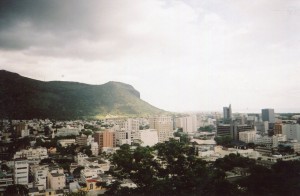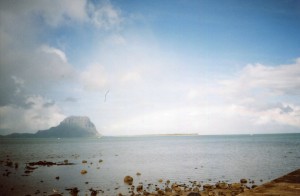Mauritius’ capital city, Port Louis, is a great sight from the fort which the British ruled from in the 19th century. Mountains, office buildings and ocean complement each other. Everything’s balanced.
Nothing’s so big that it dominates the landscape. Things seem to dance together.
I took a taxi to leave Port Louis for the small southern coastal town I was sleeping in. The congenial grey-haired driver sped up a narrow road that corkscrewed up the southern hill (around the bottom right of the cliff in the pic). It had rained in the morning, but the clouds had scattered and the sun shined in full glory. The weather often changed quickly throughout my stay. Suddenly I’d be caught in a downpour and it would immediately clear up. The untrammeled sun then blessed the freshly cleaned fields and homes–everything glistened.
Scenes changed quickly in Mauritius. Storm and sunshine, town and country, sugarcane fields and craggy mountains, land and ocean, Hindu temples, Christian churches and mosques–moods, sights and cultures shifted in pulsating rhythms.
In the evening I carried my guitar along the beach in front of my hotel. 7 or 8 people sitting in a circle were singing and two were bending strings. I sat where they could see me, and within 2 minutes a young man invited me over. All were in their 20’s and 30’s. There were 4 local men, 2 French women and a male engineer from Germany. We all played reggae, classic rock and French folk songs. All the styles fused as easily as everything in the natural environment.
My whole stay in Mauritius was full of these quick and easygoing shifts between different cultural patterns and aspects of nature. India and China are huge lands which can engulf–they accept you on their terms. But no single ethnic group or language dominates Mauritius. Lots of cultural forms often dance like the scenery. This is a different way to integrate different mindsets, but it’s a sure fun, and a great model for today’s globalized world.



Comments on this entry are closed.